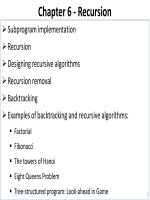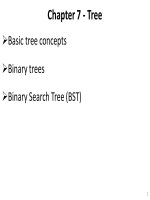Data Structures and Algorithms - Chapter 6 -Recursion pot
Bạn đang xem bản rút gọn của tài liệu. Xem và tải ngay bản đầy đủ của tài liệu tại đây (1016.35 KB, 85 trang )
Chapter 6 - Recursion
Subprogram implementation
Recursion
Designing recursive algorithms
Recursion removal
Backtracking
Examples of backtracking and recursive algorithms:
Factorial
Fibonacci
The towers of Hanoi
Eight Queens Problem
Tree-structured program: Look-ahead in Game
1
Subprogram implementation
2
Subprogram implementation
3
Subprogram implementation
4
Subprogram implementation
5
Tree and Stack frames of function calls
6
Tree and Stack frames of function calls
Stack frames:
Each vertical column shows the contents of the stack at
a given time
There is no difference between two cases:
o when the temporary storage areas pushed on the stack come
from different functions, and
o when the temporary storage areas pushed on the stack come
from repeated occurrences of the same function.
7
Recursion
8
Recursion
9
Recursion
Recursion is the name for the case when:
• A function invokes itself, or
• A function invokes a sequence of other functions, one
of which eventually invokes the first function again.
In regard to stack frames for function calls, recursion is no
different from any other function call.
Stack frames illustrate the storage requirements for recursion.
Separate copies of the variables declared in the function are created for
each recursive call.
10
Tree and Stack frames of function calls
11
E
E E
F
F
D
E
Tree and Stack frames of function calls
Recursive calls:
12
M
M
M
M
M
M
M
M M
M
M M M M
M
M
M
M
M
M
M M
M
M
M
M
M
M
Recursion
In the usual implementation of recursion, there are kept on a
stack.
The amount of space needed for this stack depends on the depth of
recursion, not on the number of times the function is invoked.
The number of times the function is invoked (the number of nodes in
recursive tree) determines the amount of running time of the program.
13
Recursion
14
Print List
15
6 10 14 20
Print List
A list is
• empty, or
• consists of an element and a sublist, where sublist is a
list.
16
17
Print List
17
6 10 14 20
18
Print List
Algorithm Print(val head <pointer>)
Prints Singly Linked List.
Pre head points to the first element of the list needs to be printed.
Post Elements in the list have been printed.
Uses recursive function Print.
1. if (head = NULL) // stopping case
1. return
2. write (head->data)
3. Print(head->link) // recursive case
End Print
18
Print List in Reverse
19
Print List in Reverse
20
Print List in Reverse
Algorithm PrintReverse(val head <pointer>)
Prints Singly Linked List in reverse.
Pre head points to the first element of the list needs to be printed.
Post Elements in the list have been printed in reverse.
Uses recursive function PrintReverse.
1. if (head = NULL) // stopping case
1. return
2. PrintReverse(head->link) // recursive case
3. write (head->data)
End PrintReverse
21
Factorial: A recursive Definition
22
Iterative Solution
Algorithm IterativeFactorial (val n <integer>)
Calaculates the factorial of a number using a loop.
Pre n is the number to be raised factorial, n >= 0.
Post n! is returned.
1. i = 1
2. factN = 1
3. loop (i <= n)
1. factN = factN * i
2. i = i + 1
4. return factN
End IterativeFactorial
23
Recursive Solution
Algorithm RecursiveFactorial (val n <integer>)
Caculates the factorial of a number using recursion.
Pre n is the number to be raised factorial, n >= 0
Post n! is returned.
Uses recursive function RecursiveFactorial
1. if (n = 0)
1. factN = 1 // stopping case
2. else
1. factN = n * RecursiveFactorial(n-1) // recursive case
3. return factN
End RecursiveFactorial
24
Recursive Solution
The recursive definition and recursive solution can be both concise
and elegant.
The computational details can require keeping track of many partial
computations before the process is complete.
25









